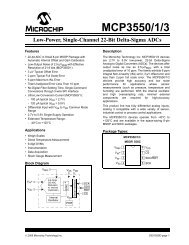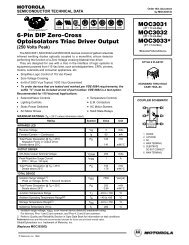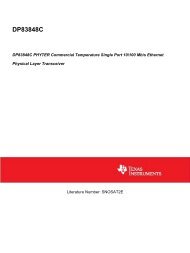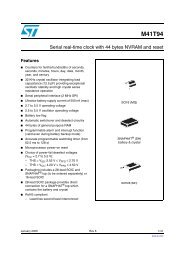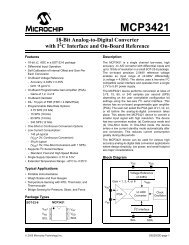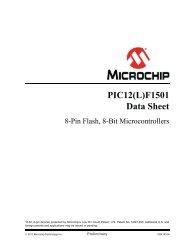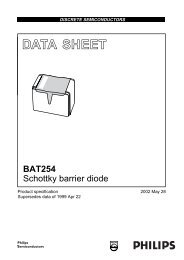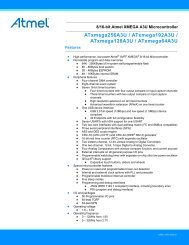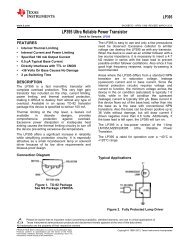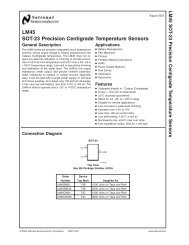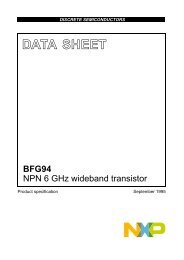MCP3001 2.7V 10-Bit A/D Converter with SPI Serial ... - Microchip
MCP3001 2.7V 10-Bit A/D Converter with SPI Serial ... - Microchip
MCP3001 2.7V 10-Bit A/D Converter with SPI Serial ... - Microchip
You also want an ePaper? Increase the reach of your titles
YUMPU automatically turns print PDFs into web optimized ePapers that Google loves.
<strong>MCP3001</strong>6.0 APPLICATIONS INFORMATION6.1 Using the <strong>MCP3001</strong> <strong>with</strong>Microcontroller <strong>SPI</strong> PortsWith most microcontroller <strong>SPI</strong> ports, it is required toclock out eight bits at a time. If this is the case, it will benecessary to provide more clocks than are required forthe <strong>MCP3001</strong>. As an example, Figure 6-1 andFigure 6-2 show how the <strong>MCP3001</strong> can be interfacedto a microcontroller <strong>with</strong> a standard <strong>SPI</strong> port. Since the<strong>MCP3001</strong> always clocks data out on the falling edge ofclock, the MCU <strong>SPI</strong> port must be configured to matchthis operation. <strong>SPI</strong> Mode 0,0 (clock idles low) and <strong>SPI</strong>Mode 1,1 (clock idles high) are both compatible <strong>with</strong>the <strong>MCP3001</strong>. Figure 6-1 depicts the operation shownin <strong>SPI</strong> Mode 0,0, which requires that the CLK from themicrocontroller idles in the ‘low’ state. As shown in thediagram, the MSB is clocked out of the ADC on the fallingedge of the third clock pulse. After the first eightclocks have been sent to the device, the microcontroller’sreceive buffer will contain two unknown bits (theoutput is at high impedance for the first two clocks), thenull bit and the highest order five bits of the conversion.After the second eight clocks have been sent to thedevice, the MCU receive register will contain the lowestorder five bits and the B1-B4 bits repeated as the ADChas begun to shift out LSB first data <strong>with</strong> the extraclocks. Typical procedure would then call for the lowerorder byte of data to be shifted right by three bits toremove the extra B1-B4 bits. The B9-B5 bits are thenrotated 3 bits to the right <strong>with</strong> B7-B5 rotating from thehigh order byte to the lower order byte. Easier manipulationof the converted data can be obtained by usingthis method.Figure 6-2 shows <strong>SPI</strong> Mode 1,1 communication whichrequires that the clock idles in the high state. As <strong>with</strong>mode 0,0, the ADC outputs data on the falling edge ofthe clock and the MCU latches data from the ADC in onthe rising edge of the clock.CSMCU latches data from ADCon rising edges of SCLKCLK 1 2 3 4 5 6 7 8 9 <strong>10</strong> 11 12 13 14 15 16Data is clocked out ofADC on falling edgesD OUTHI-ZNULLBITB9 B8 B7 B6 B5 B4 B3 B2 B1 B0 B1 B2B3 B4HI-ZLSB first data beginsto come out? ? 0B9 B8 B7 B6B5 B4 B3 B2 B1 B0 B1 B2B3Data stored into MCU receive registerafter transmission of first 8 bitsData stored into MCU receive registerafter transmission of second 8 bitsFIGURE 6-1:<strong>SPI</strong> Communication <strong>with</strong> the <strong>MCP3001</strong> using 8-bit segments (Mode 0,0: SCLK idles low).CSMCU latches data from ADCon rising edges of SCLKCLK 1 2 3 4 5 6 7 8 9 <strong>10</strong> 11 12 13 14 15 16Data is clocked out ofADC on falling edgesD OUTHI-ZNULLBITB9 B8 B7 B6 B5 B4 B3 B2 B1 B0 B1 B2B3HI-ZLSB first data beginsto come out? ? 0B9 B8 B7 B6B5 B4 B3 B2 B1 B0 B1 B2B3Data stored into MCU receive registerafter transmission of first 8 bitsData stored into MCU receive registerafter transmission of second 8 bitsFIGURE 6-2:<strong>SPI</strong> Communication <strong>with</strong> the <strong>MCP3001</strong> using 8-bit segments (Mode 1,1: SCLK idles high).DS21293C-page 16© 2007 <strong>Microchip</strong> Technology Inc.



